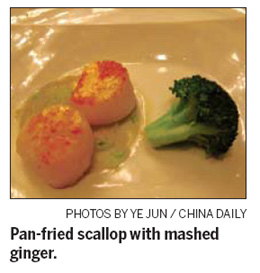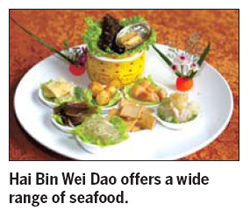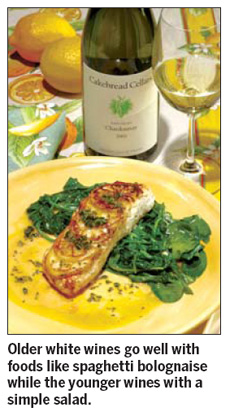Food reviews
The best of a Michelin Star chef

Chef Tam Sek Lun said his secret of cooking is the use of the best ingredients. Besides, "don't over-cook seafood," he advised recently at the Marriott International Hotel Beijing. He was on a culinary tour of Beijing and Tianjin, after being awarded One Michelin Star by The Michelin Guide Hong Kong Macao 2010.
One of the best received dishes was pan-fried scallop with ginger, served on a sauce of mashed ginger with spring onion. The scallops were both fresh and flavorful.
In fact, all of Chef Tam's seafoods - shark fin, grouper fish, and a sauted prawn ball with XO sauce - reflected his belief in sourcing the best ingredients. Even the lettuce served with braised sliced abalone was super crisp and crunchy.
Wanton with spinach stock was another winner. Even though it appeared toward the end of the meal, many wanted to polish off even the soup.
Tam will leave behind six of his signature Michelin dishes to be featured in the hotel's menus, including fried shark's fin with sweet-scented osmanthus in casserole, yellow-smoked chicken with soy sauce, braised shark's fin in shark bone soup, sauted Shunde pork rib, and wanton with spinach stock.
Haven for Beijing's seafood lovers
Hai Bin Wei Dao (Seashore Flavor) Restaurant is a haven for seafood lovers. Its dishes are drawn from Shandong's Qingdao, a seaside city, and come at very reasonable prices.

"Buddha jumps over the wall" soup would cost a fortune elsewhere, but is priced at only 68 yuan ($10) per person here. The soup has a variety of ingredients slow-cooked, including sea cucumber, shark's fin, abalone, fish maw and pork tendon.
Sea urchin is steamed with egg. Poached clams are served fresh and imaginatively. Big-sized oysters come steamed and flavored with mashed garlic.
The eatery offers quite a few "mountain treasures" from Qingdao's Laoshang Mountain - famous for its Taoist beliefs - such as dried mushrooms and mountain ginseng.
Another specialty of the restaurant established in 1925 is jiaozi with seafood stuffing. In Shandong, mackerel has traditionally been used as a tasty stuffing for jiaozi. But the restaurant has developed the variety of stuffings to include yellow croaker, inkfish, prawn, sea cucumber and abalone.
Decoration is ordinary, with live seafood in tanks, and pictures of Qingdao on the walls. The average bill is 100 yuan per person.

9:30 am-2 pm, 4:30-9 pm. Inside Hangying Hotel, opposite Jing Ya Seafood Restaurant, 28 Huangsi Dajie, Chaoyang district, Beijing. 010-6887-5588
Getting the best out of white wines
Cakebread Cellars' recent Chardonnay tasting provided a good chance to see how white wine ages and changes over the years in a bottle. At this tasting organized by ASC Fine Wines at Aria Restaurant, Bruce Cakebread, president of Cakebread Cellars, introduced six Chardonnay wines - from 2005 to 2008, besides one from 2009 directly from the barrel, and another from 1999.
It was interesting to see how the white wine changed from refreshingly aromatic, with awakening acidity, to a rounder, more closed down, but deeper and more powerful taste and fragrance.
With the 1999 Chardonnay, the changes were even bigger. At first the wine had a smell resembling fruit vinegar, a popular drink in China's Shanxi. It took as long as an hour to have the fragrance and body recover to a deep, round fragrance, and mellow taste. Cakebread said the 1999 was best poured directly into the glass to see it change.
Cakebread said 2005, as well as 2007, were good years that were not too cold, not too warm.
Established in 1973 in Napa Valley, Cakebread Cellars is located in the heart of Napa's famous Rutherford district, and is known for producing high quality Cabernet and Chardonnay in a style that is enjoyable when young or after cellaring.
Cakebread suggests serving older white wines with foods such as spaghetti bolognaise, and younger white wines such as Cakebread Chardonnay 2008 with a simple salad.
(China Daily 05/08/2010 page12)














